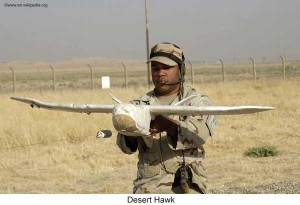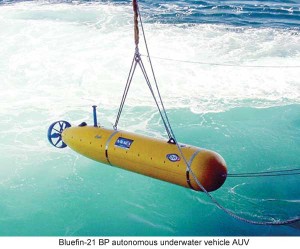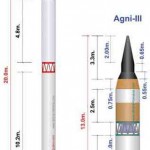The existing UGV technology guarantees performance levels at par with the human performance on well-delineated roads in dry weather during daytime with the average vehicle speed of 60mph. The problem exists with off-road operations and during bad weather. Particularly, navigation and obstacle avoidance is a major concern. Also, few other difficult issues like requirement of colour sensors for object identification, anticipating obstacles and hazards at a greater distance (because faster moving UGV would require a greater stopping distance) need to be resolved12.UGVs have two subcategories, Autonomous Vehicles and Teleoperated Vehicles. Like the UAV family they also have Unmanned Ground Combat Vehicles (UGCV) capable of firing on their own or under instructions from the operator. An autonomous UGV is essentially a vehicle that operates on the surface of the ground without any human assistance for navigation and performs designed operations. While the teleoperated UGV is a human operator controlled vehicle from a distance. There are human operators available to observe the performance of the vehicle either visually or on the screen and they guide the vehicle via a wired or wireless communication. Usually, various disabling vehicles are teleoperated and landmine detection/destruction vehicles are autonomous.
Also read: India and the European Aerospace Industry
In autonomous UGVs the ‘spotlight’ is on navigation, obstacle recognition and avoidance, friend/foe recognition and decision capacities. All these functions need significant amount of computing power. The real challenge is to develop hardware and compatible software to carryout such tasks. While the major problem of navigation is addressed by the human operator located at a distance in case of the teleoperated systems. This allows the UGV to undertaken its basic functions with lot of ease.
As per their 2010 report11 even during the era of recession the UAV sector continued to be the most dynamic growth sector of the world aerospace industry. It has been estimated that UAV spending would double over the next decade”¦
The Goliath was one of the first UGVs used as a mobile, armored explosive platform for pillbox, obstacle, and stronghold destruction. This was an operator controlled and detonated device through a 400-meter electric cable, which spooled from the rear of a “mother” vehicle or trailer. The first field use of this unit was made in 1944 but even today this technology is still in nascent stage of development13. The US has been the leader in the UGV technology and their Army Research Lab’s have been involved in developing this technology for many years. The major focus on this research has started since mid 1990s. In September 1999 the first two unmanned vehicles were deployed during troop exercises at Aberdeen Proving Ground, Md. The following year, troops at Fort Knox, Ky., put the vehicles to the test during day and night operations. Subsequent experiments were for testing the tactical and cooperative behaviors of unmanned vehicles14. During 2002 the agency of the United States Department of Defence called Defence Advanced Research Projects Agency (DAPRA) had awarded Carnegie Mellon University’s National Robotics Engineering Consortium and teammate Boeing US$5.5 million to build and test a prototype robotic unmanned ground combat vehicle or UGCV15. Presently, few UGCV are found operational in the Iraq and Afghanistan Theaters.
Like the Air Forces and Armies of developed countries the navies too are keenly investing into the unmanned technology-underwater unmanned vehicles (UUVs). Thse vehicles also have two subcategories like UGVs. They are the autonomous underwater vehicles and the remotely operated underwater vehicles. The development of such systems is under progress since with mind 1950s and particularly the various US agencies are taking a lead in this field. Such systems are expected to be more cost effective than submarines at least for some specific tasks. These underwater vehicles are used for intelligence gathering and surveillance. They have utility in mine warfare and undersea environmental sensing and mapping. They are employed in anti-submarine warfare, to assist in the detection of submarines.
In recent years UUVs were deployed in support of Operation Iraqi Freedom. During March 2003 the Naval Special Clearance Team (NSCT-the US Navy mine countermeasures), along with Royal Navy and Australian forces had successfully handled the task of exploratory mine hunting to provide the port safe for incoming humanitarian aid shipments. NSCT also conducted additional UUV operations further up the river at Az Zubayr and Karbala, Iraq. It went into action by initially checking the river waters and bottom for mines16.
UUVs could play a vital role in respect of tactical oceanographic measurements. Such measurements particularly in politically sensitive or denied areas are hardest to obtain17. The UUV technology is also taking clue from the Biomimetics18 (particularly the underwater animal kingdom) for designing new products. Developments are in progress towards designing products based on the structures of Lobsters which move and operate not only on sandy bottoms but also in rocky, cave like environments. These RoboLobster carry sensors that would detect metal, chemicals, explosive signatures and plumes of other underwater vehicles19.
The University of Michigan with the help of funding from DAPRA has developed an unmanned seaplane. The self-governing craft is supposed to be the first seaplane that can initiate and perform its own takeoffs and landings on water. It has been named as the Flying Fish after its inspiration. Its takeoff and landing are GPS guided. The work is under progress to outfit the plane with solar power and to add more sensors20. Apart from US few other states have also started investing this technology. France launched pilotless mine-hunting vessel and its details were disclosed on Dec 10, 2010 with its launch in the northwestern waters off the country. The unmanned surface vessel (USV) meant for ‘mine counter-operations’ is about 17 metres long and weighing 25 tonnes. It is expected to be equipped with sonar in 2011 21.






